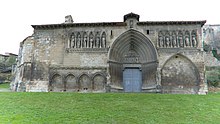San Sepulcro (Estella)
The church of San Sepulcro in Estella-Lizarra , a Spanish city in the Navarra region , is the structural remainder of what was once a much larger church.
Geographical location
The Church of the Holy Sepulcher is located on the old pilgrimage route at the eastern core of the historic old town.
history
The church was one of the city's historic parish churches. As early as 1123 it was the seat of a brotherhood of the Holy Sepulcher. At the beginning of the 19th century, the building was largely in ruins. Only the north aisle was restored, the other two naves abandoned and their material sold for demolition. Since the area in which the church stands, increasingly lost its inhabitants at the end of the 19th century, it was given up as a parish church in 1881, the parish of the Church of San Pedro de la Rúa was added.
building
Structure
The church shows traces of numerous alterations. It began in the Romanesque , in the last third of the 12th century. It was changed again and again until the 16th century. In the 14th century, the apse of the main nave and the south aisle were built with an apse, both ends were polygonal .
The entire height of the northern nave with its semicircular apse has been preserved to this day . Remnants of the walls of the main nave are still preserved, while only the foundations of the south aisle have remained. The church is therefore single-nave today.
North portal
The north portal, now the main entrance, is an important Gothic work from around 1340. It is richly carved. The tympanum is divided into three levels: the lower level shows The Last Supper , the upper level the crucifixion . The central level is divided into three scenes: the three women at the grave on the left , the rescue of the justified in the middle and Noli me tangere on the right . To the left and right of the tympanum and arch there are six small archivolts framed by columns with figures of the apostles . The capitals of the columns are decorated with plant and zoomorphic motifs. To the right and left of the entrance are figures of the Apostle Jacob and Saint Martin . According to another source, the second figure is "a bishop".
Furnishing
From the original furnishings of the church there is a statue of the Virgin Mary, a carving from the late 13th century, in the presbytery of the Church of San Pedro de la Rúa in Estella.
literature
- Dietrich Höllhuber and Werner Schäfke : The Spanish Way of St. James. History and art on the way to Santiago de Compostela. DuMont, Cologne 1999, ISBN 3-7701-4862-2 .
- Werner Schäfke: Northwest Spain. Landscape, history and art on the way to Santiago de Compostela. DuMont, Cologne 1987, ISBN 3-7701-1589-9 .
- Pierre Tisné et al: Spain. Pictorial Atlas of Spanish Art. DuMont Schauberg, Cologne 1968, ISBN 3-7701-4461-9 .
Individual evidence
- ↑ NN: Labeling on the building.
- ↑ NN: Labeling on the building.
- ↑ Höllhuber: The Spanish Way of St. James , p. 93; Schäfke: Northwest Spain , p. 76; Tisné: Spain , p. 256.
- ↑ NN: Labeling on the building.
- ↑ Höllhuber: The Spanish Way of St. James , p. 93; Schäfke: Northwest Spain , p. 76; Tisné: Spain , p. 256.
- ↑ NN: Labeling on the building.
Coordinates: 42 ° 40 '10.9 " N , 2 ° 1' 30.8" W.

